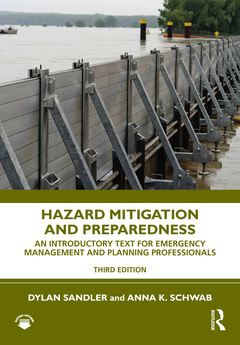Hazard Mitigation and Preparedness (3rd Ed.) An Introductory Text for Emergency Management and Planning Professionals
Auteurs : Sandler Dylan, Schwab Anna K.

An essential text for today?s emerging professionals and higher education community, the third edition of Hazard Mitigation andPreparedness provides accessible and actionable strategies to create safer, more resilient communities. Known and valued for its balanced approach, Hazard Mitigation and Preparedness assumes no prior knowledge of the subject, presenting the major principles involved in preparing for and mitigating the impacts of hazards in emergency management. Real-world examples of different tools and techniques allow for the application of knowledge and skills.
This new edition includes:
- Updates to case studies and sidebars with recent disasters and mitigation efforts, including major hurricanes, wildfires, earthquakes, and the COVID-19 pandemic.
- Summary of the National Flood Insurance Program, including how insurance rates are determined, descriptions of flood maps, and strategies for communities to help reduce premiums for residents.
- Overview of the ways that climate change is affecting disasters and the tools that emergency managers can use to plan for an uncertain future.
- Best practices in communication with the public, including models for effective use of social media, behavioral science techniques to communicate information about risk and preparedness actions, and ways to facilitate behavior change to increase the public?s level of preparedness.
- Actionable information to help emergency managers and planners develop and implement plans, policies, and programs to reduce risk in their communities.
- Updated in-text learning aids, including sidebars, case studies, goals and outcomes, key terms, summary questions and critical thinking exercises for students.
- An eResource featuring new supplemental materials to assist instructors with course designs. Supplements include PowerPoint slides, tests, instructor lecture notes and learning objectives, key terms and a course syllabus.
Chapter 1: Hazards and Disasters Chapter 2: Preparedness, Hazard Mitigation, and Climate Change Part 1 Introduction Chapter 3: Meteorological and Hydrological Hazards: Hurricanes, Sea Level Rise, Floods, Drought, Wildfire, Tornadoes, Severe Winter Weather, and Extreme Heat Chapter 4: Geological Hazards: Earthquakes, Tsunamis, Volcanoes, Landslides, Coastal Erosion, and Land Subsidence Chapter 5: Human-Made Hazards: Terrorism, Civil Unrest and Technological Hazards Part 2 Introduction Chapter 6: Role of the Federal Government in Disaster Management Chapter 7: Mitigating Hazards at the State Level Chapter 8: Local Government Powers: Building Resilience from the Ground Up Chapter 9: Community Resilience and the Private Sector Part 3 Introduction Chapter 10: Risk Assessment: Identifying Hazards and Vulnerability Chapter 11: Preparedness Activities: Planning to Be Ready When Disaster Hits Chapter 12: Hazard Mitigation Planning: Creating Strategies to Reduce Vulnerability Part 4 Introduction Chapter 13: Disaster Resilience: Living With Our Environment
Dylan Sandler serves as a Senior Planner at the New York City Department of City Planning. In this role, he manages citywide zoning changes and advises the City Planning Commission on land use policy. His areas of focus include hazard mitigation, climate adaptation, distributed energy production and battery storage, urban agriculture, industrial policy, and economic development. Following Hurricane Sandy, Mr. Sandler served as the project manager of the Resilient Industry Study, an initiative to help industrial businesses recover from damage caused by Hurricane Sandy and reduce risk during future events. He also serves as the agency’s liaison on the city’s Hazard Mitigation Plan. Previously, Mr. Sandler worked as a consultant supporting the National Oceanic and Atmospheric Administration to implement that National Climate Action Plan and the National Ocean Policy. In this role, Mr. Sandler facilitated communication and policy development across federal agencies focused on coastal planning and climate mitigation and adaptation. Mr. Sandler also served as a research associate at the Center for the Study of Natural Hazards and Disasters located at the University of North Carolina at Chapel Hill, where he conducted applied research regarding hazard mitigation, sea level rise adaptation and disaster recovery planning, and helped maintain the Center’s website and social media. Mr. Sandler has direct experience with hazard mitigation planning at the local and state level. Working with the North Carolina Division of Emergency Management, he reviewed local plans for state and federal compliance, authored a chapter on climate change for the North Carolina State Hazard Mitigation Plan, and helped compile materials used in training sessions for hazard mitigation planners.
Anna K. Schwab is program manager at the US Department of Homeland Security Coastal Resilience Center of Excellence (CRC) administered at the University of North Carolina at C
Date de parution : 09-2021
17.8x25.4 cm
Thème de Hazard Mitigation and Preparedness :
Mots-clés :
Hazard Mitigation; natural; Flood Insurance; event; Hazard Mitigation Plan; climate; Natural Hazards; change; FEMA; emergency; Climate Change; management; Climate Change Adaptation; storm; Emergency Management Cycle; surge; NFIP; plan; Hazard Profile; sea; FIRMs; DMA; Comprehensive Emergency Management System; Hazards Management; Hazard Prone Areas; Hazard Event; Comprehensive Emergency Management; Subdivision Ordinances; Natural Hazard Events; Moment Magnitude Scale; Emergency Management; Floodplain Management; Hazard Areas; Green Infrastructure; Hazard City


